Abstract
We compared the effects of sensory and edible reinforcers on resistance to satiation in three autistic children while learning visual discrimination tasks. Within-subject designs were used to compare a single sensory reinforcer with a single edible reinforcer and to compare multiple sensory reinforcers with multiple edibles. Results indicated that multiple sensory reinforcers maintained responding over more trials than did multiple edible reinforcers; however, the use of single sensory reinforcers and single edibles resulted in about equal numbers of trials to satiation. Both multiple and single sensory reinforcers produced higher percentages of correct responses than edible reinforcers. The findings are discussed in terms of the advantages of sensory reinforcers in teaching autistic children.
Full text
PDF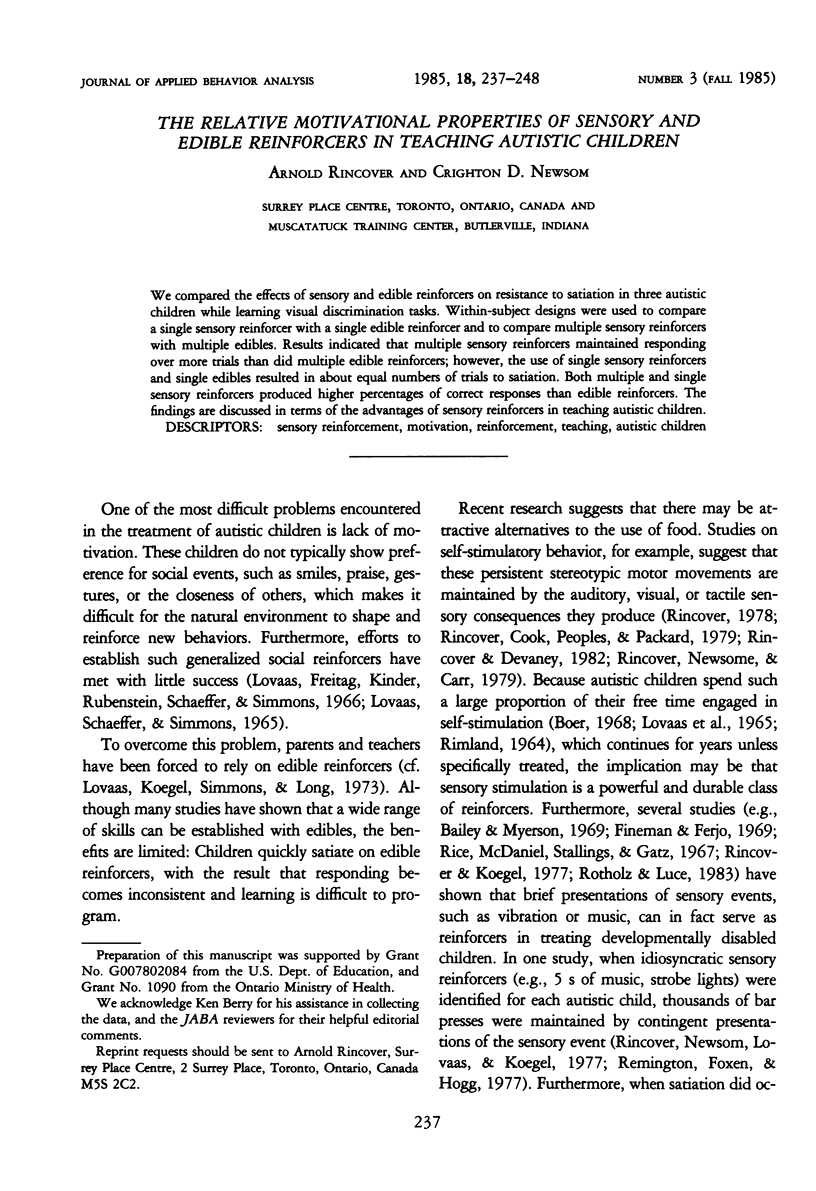

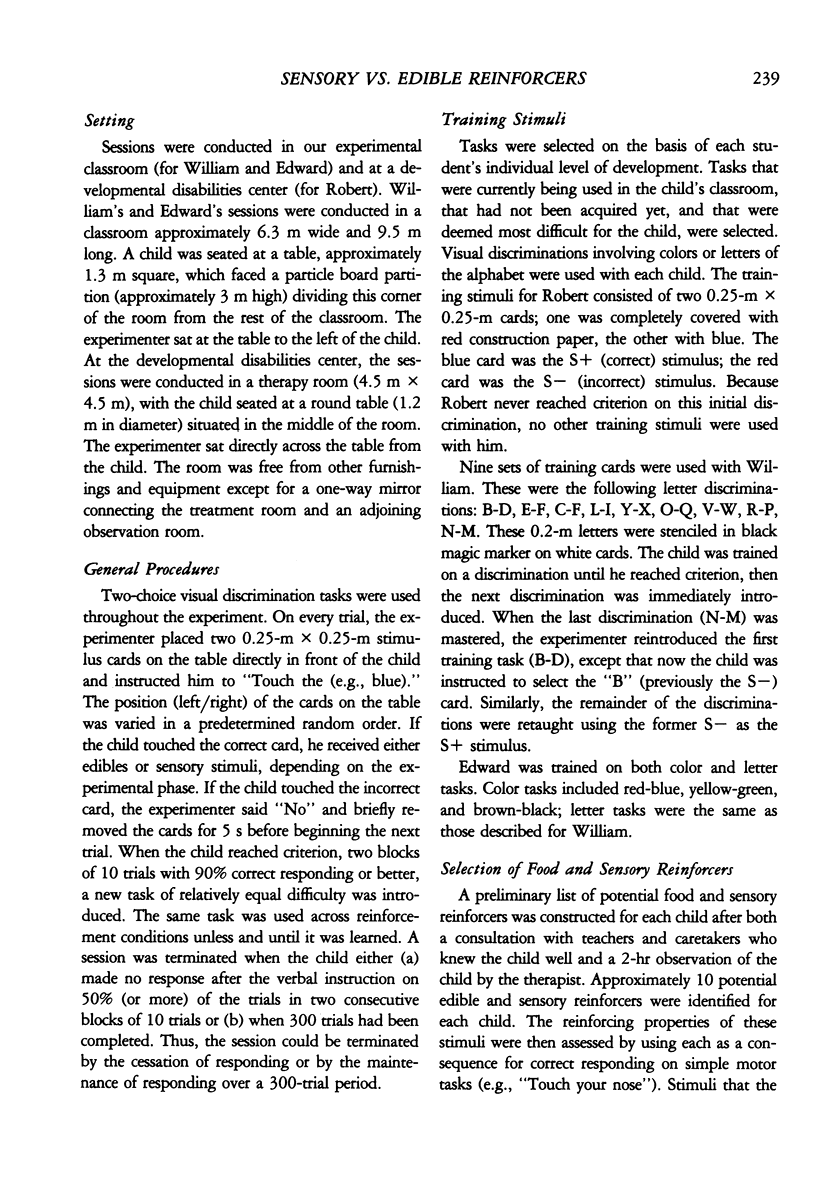
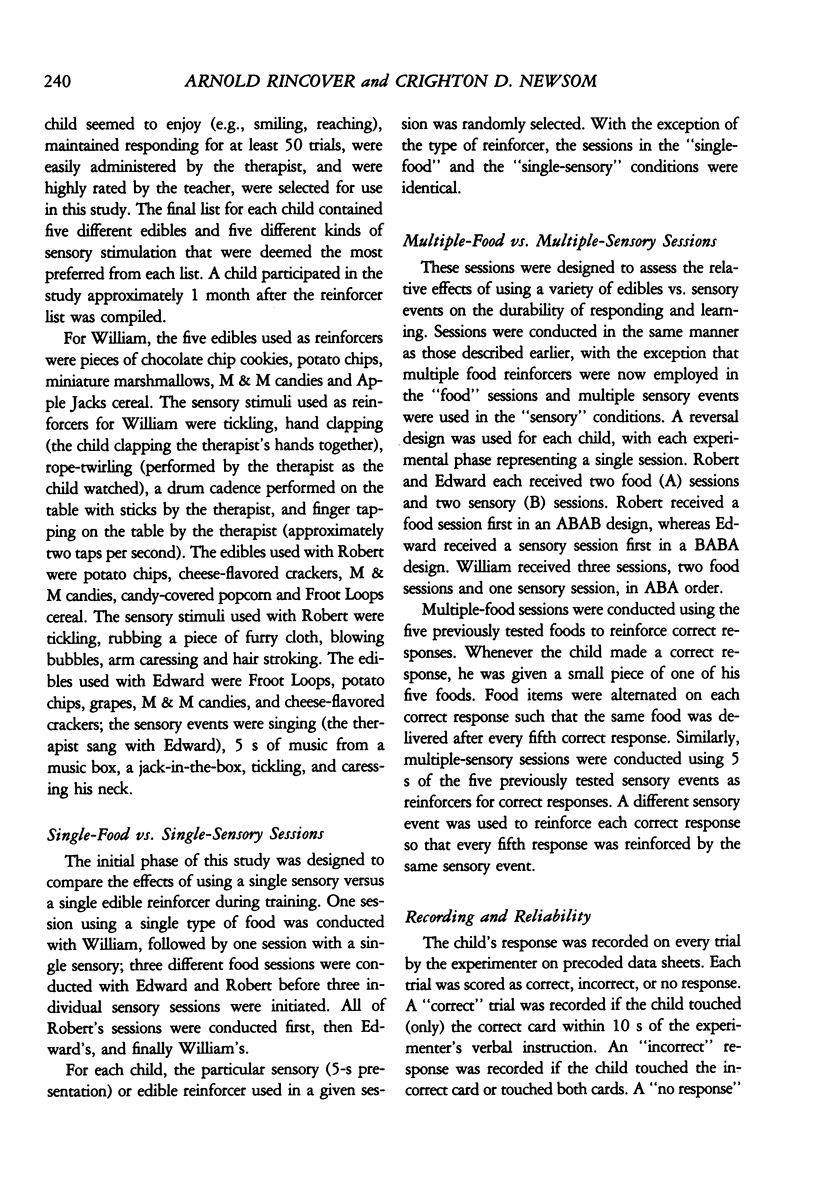



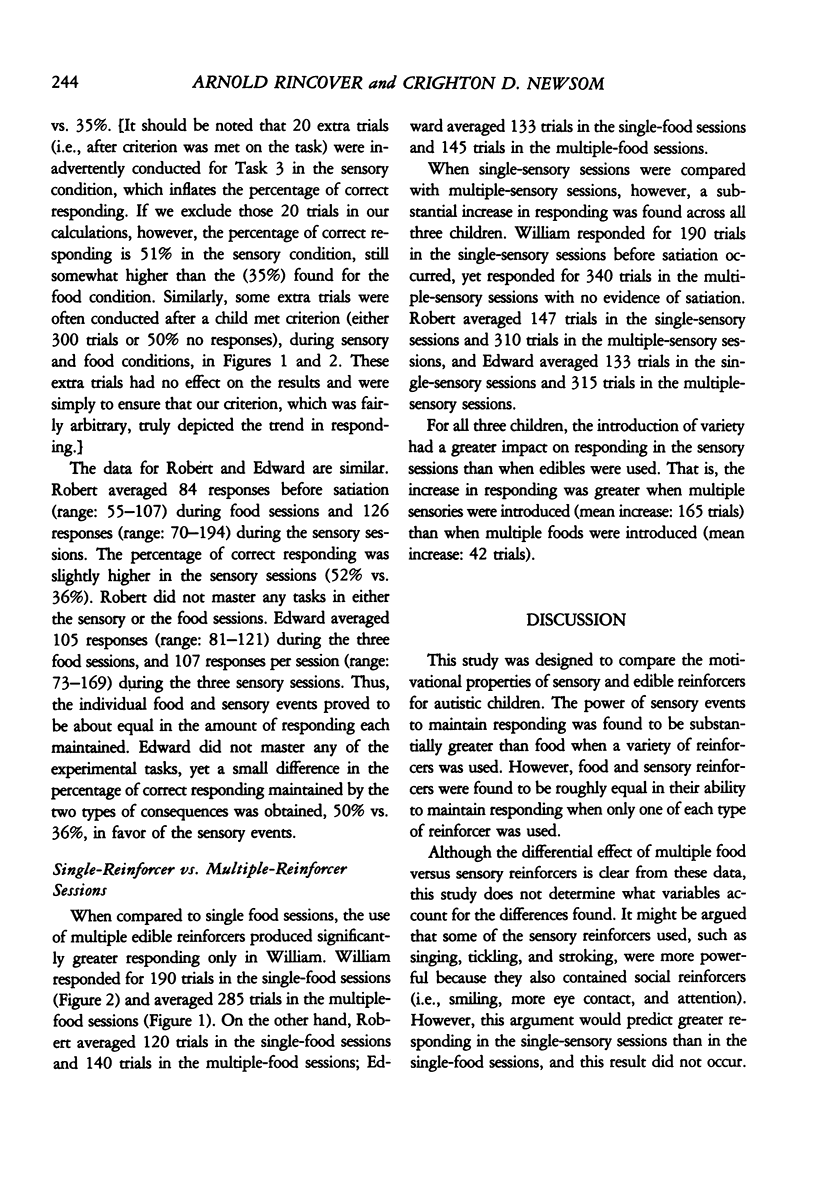


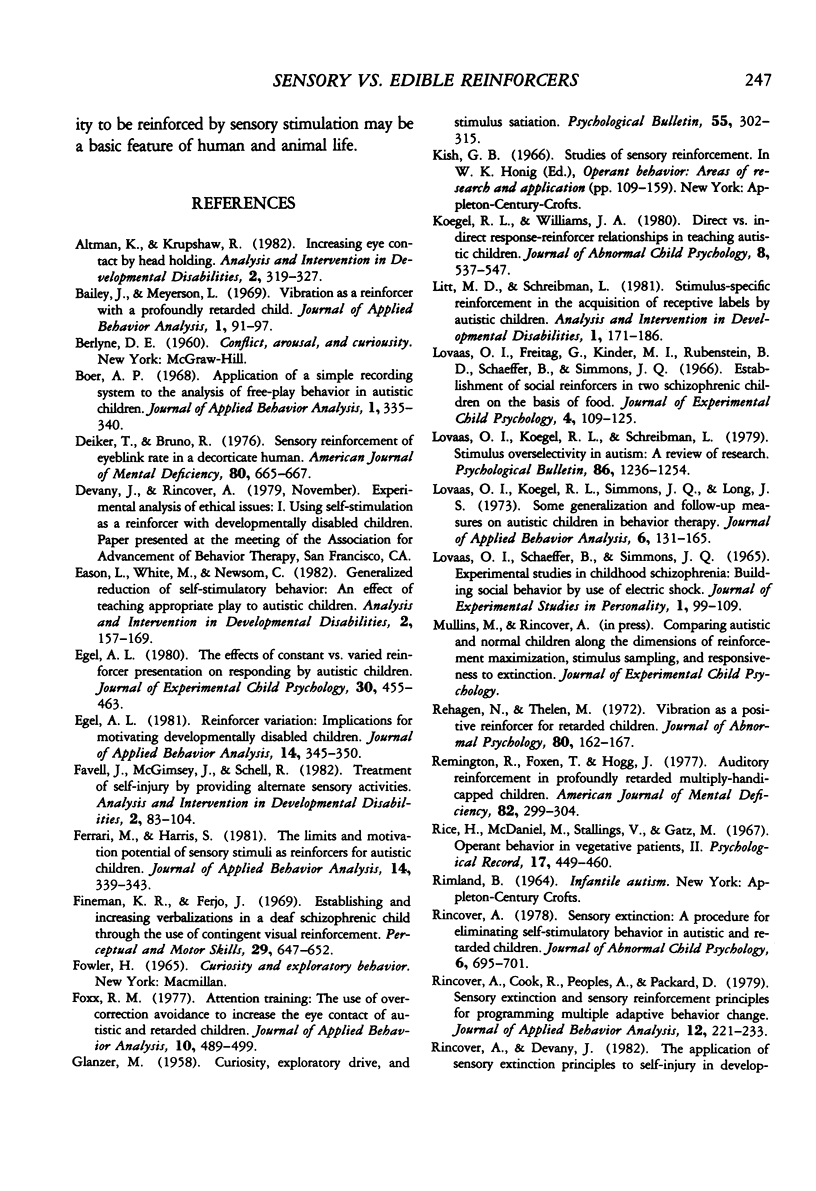

Selected References
These references are in PubMed. This may not be the complete list of references from this article.
- Boer A. P. Application of a simple recording system to the analysis of free-play behavior in autistic children. J Appl Behav Anal. 1968 Winter;1(4):335–340. doi: 10.1901/jaba.1968.1-335. [DOI] [PMC free article] [PubMed] [Google Scholar]
- Deiker T., Bruno R. D. Sensory reinforcement of eyeblink rate in a decorticate human. Am J Ment Defic. 1976 May;80(6):665–667. [PubMed] [Google Scholar]
- Egel A. L. Reinforcer variation: implications for motivating developmentally disabled children. J Appl Behav Anal. 1981 Fall;14(3):345–350. doi: 10.1901/jaba.1981.14-345. [DOI] [PMC free article] [PubMed] [Google Scholar]
- Egel A. L. The effects of constant vs varied reinforcer presentation on responding by autistic children. J Exp Child Psychol. 1980 Dec;30(3):455–463. doi: 10.1016/0022-0965(80)90050-8. [DOI] [PubMed] [Google Scholar]
- Ferrari M., Harris S. L. The limits and motivating potential of sensory stimuli as reinforcers for autistic children. J Appl Behav Anal. 1981 Fall;14(3):339–343. doi: 10.1901/jaba.1981.14-339. [DOI] [PMC free article] [PubMed] [Google Scholar]
- Fineman K. R., Ferjo J. Establishing and increasing verbalizations in a deaf schizophrenic child through the use of contingent visual-color reinforcement. Percept Mot Skills. 1969 Oct;29(2):647–652. doi: 10.2466/pms.1969.29.2.647. [DOI] [PubMed] [Google Scholar]
- Foxx R. M. Attention training: the use of overcorrection avoidance to increase the eye contact of autistic and retarded children. J Appl Behav Anal. 1977 Fall;10(3):489–499. doi: 10.1901/jaba.1977.10-489. [DOI] [PMC free article] [PubMed] [Google Scholar]
- GLANZER M. Curiosity, exploratory drive, and stimulus satiation. Psychol Bull. 1958 Sep;55(5):302–315. doi: 10.1037/h0044731. [DOI] [PubMed] [Google Scholar]
- Koegel R. L., Williams J. A. Direct versus indirect response-reinforcer relationships in teaching autistic children. J Abnorm Child Psychol. 1980 Dec;8(4):537–547. doi: 10.1007/BF00916505. [DOI] [PubMed] [Google Scholar]
- Lovaas O. I., Freitag G., Kinder M. I., Rubenstein B. D., Schaeffer B., Simmons J. Q. Establishment of social reinforcers in two schizophrenic children on the basis of food. J Exp Child Psychol. 1966 Oct;4(2):109–125. doi: 10.1016/0022-0965(66)90011-7. [DOI] [PubMed] [Google Scholar]
- Lovaas O. I., Koegel R. L., Schreibman L. Stimulus overselectivity in autism: a review of research. Psychol Bull. 1979 Nov;86(6):1236–1254. [PubMed] [Google Scholar]
- Lovaas O. I., Koegel R., Simmons J. Q., Long J. S. Some generalization and follow-up measures on autistic children in behavior therapy. J Appl Behav Anal. 1973 Spring;6(1):131–165. doi: 10.1901/jaba.1973.6-131. [DOI] [PMC free article] [PubMed] [Google Scholar]
- Rehagen N. J., Thielen M. H. Vibration as positive reinforcement for retarded children. J Abnorm Psychol. 1972 Oct;80(2):162–167. doi: 10.1037/h0033410. [DOI] [PubMed] [Google Scholar]
- Remington R. E., Foxen T., Hogg J. Auditory reinforcement in profoundly retarded multiply handicapped children. Am J Ment Defic. 1977 Nov;82(3):299–304. [PubMed] [Google Scholar]
- Rincover A., Cook R., Peoples A., Packard D. Sensory extinction and sensory reinforcement principles for programming multiple adaptive behavior change. J Appl Behav Anal. 1979 Summer;12(2):221–233. doi: 10.1901/jaba.1979.12-221. [DOI] [PMC free article] [PubMed] [Google Scholar]
- Rincover A., Newsom C. D., Carr E. G. Using sensory extinction procedures in the treatment of compulsivelike behavior of developmentally disabled children. J Consult Clin Psychol. 1979 Aug;47(4):695–701. doi: 10.1037//0022-006x.47.4.695. [DOI] [PubMed] [Google Scholar]
- Rincover A., Newsom C. D., Lovaas O. I., Koegel R. L. Some motivational properties of sensory stimulation in psychotic children. J Exp Child Psychol. 1977 Oct;24(2):312–323. doi: 10.1016/0022-0965(77)90009-1. [DOI] [PubMed] [Google Scholar]
- Siqueland E. R. Reinforcement patterns and extinction in human newborns. J Exp Child Psychol. 1968 Sep;6(3):431–442. doi: 10.1016/0022-0965(68)90124-0. [DOI] [PubMed] [Google Scholar]


